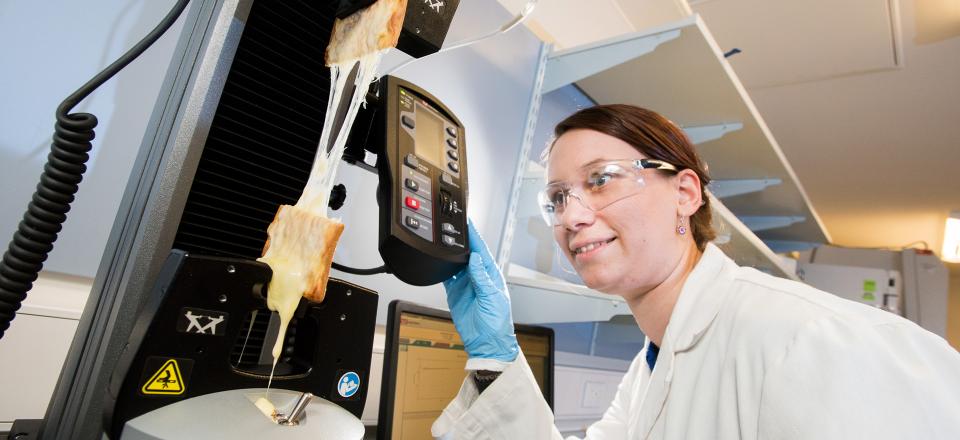Molecular Mozzarella: What makes Mozzarella stretchy?

The ARC’s Dairy Innovation Hub has been operational for 18 months, a good time to reflect on the achievements and impacts of the research program thus far. Leading food science and technology publication Food Australia recently published a feature by Barbara Meurer, Martin Palmer and Sally Gras with an overview of the Hub’s achievements and impacts on local industry to date. The Dairy Innovation Hub is an example of successful collaboration, bringing together three of Australia’s leading dairy research groups from the University of Melbourne, University of Queensland and Dairy Innovation Australia Ltd (DIAL) in a five-year research program co-funded by the dairy industry and the ARC.
Anita Pax is doing a PhD in Mozzarella; its properties and how this is reflected in its molecular structure as part of the ARC’s Dairy Innovation Hub at the Bio21 Institute:
This picture shows Mozzarella being stretched apart. “Mozzarella cheese is a popular choice for pizza because it melts nicely; you get an even coating and nice brown colour when it’s heated. Also, when you lift it you get all these strands,” explains Anita Pax, PhD student at the Dairy Innovation Hub, Bio21 Institute, University of Melbourne. “These are all properties we wish to encourage, so we’re trying to find a way to quantify how it stretches. This allows us to compare cheeses for use on pizzas," she says.
Melbourne, with its strong representation of Italian migrants, is mad about Mozzarella. The traditional knowledge of making Mozzarella was brought to Australia. Now Mozzarella is produced on an industrial scale, but manufacturers are keen to retain the properties that make Mozzarella great. Anita Pax aims to help Mozzarella producers improve their manufacturing processes.
Commercial pizza ovens are heated at 300-400 °C. Anita replicates these conditions by melting the Mozzarella cheese on a cracker at 240 °C for 4 minutes.
The sample is then transferred to an instrument that measures the force required to stretch cheese. It pulls the cheese apart at a constant speed and mimics the stretch that occurs when you lift a slice of pizza.
“More energy is required to pull the cheese apart at the start, then it stretches,” explains Anita. “The machine measures the stretch quality as the cheese is pulled apart.”
How much force is required at different lengths? Why is it stretchy?
The process of cheese-making may yield some clues:
The basic product is milk, bacteria, rennet (the enzyme that coagulates milk) and salt. This combination can create endless possibilities.
Firstly, the milk, lactic acid bacteria and rennet are heated to 38 °C, an ideal temperature for the bacteria to multiply.
As the bacteria multiply and the enzymes in the rennet work, curd (solid milk proteins) and the whey (liquid) separate out. Now the solid milk protein, called the ‘curd’ is cut into 1 cm cubes. On a microstructural level, this is a jumble of protein and fat.
The liquid whey is drained off and you are left with the curd at a pH of 5.1 – 5.2, which is ideal for stretching. The curd is heated in boiling weak brine and taken out intermittently and stretched. Following this the curd is moulded into shaped blocks or balls and packaged for consumption.
“One critical step in Mozzarella manufacture is when the curd is heated in the salty water bath, taken out and repeatedly stretched in one direction,” explains Anita.
“This is traditionally done by hand, but industrially this process is replicated using two large screws that push and stretch the curd through the hot water bath,” she says.
Variables that can affect the stretchability of Mozzarella include the type of milk, temperature, pH at various stages of the process; mechanical forces, e.g. machines stretching cheese, the saltiness of the brine.
The research group compares samples from different manufacturers and looks at the microstructure of different products. The microstructure gives a good indication of the changes occurring in the cheese.
.jpg)
Figure: Mozzarella microstructure.
“For example, in Mozzarella the protein strands are lined up. This kind of microstructure is related to the stretching. This contrasts with Cheddar cheese that has a microstructure more reminiscent of a web, where the fat is more evenly dispersed.”
Anita has always liked dairy. She started out studying food technology and worked at various dairy companies before embarking on her PhD. Anita benefits from access to the instruments such as the Electron Microscopes and other Advanced Microscopy facilities at the Bio21 Institute, which help her to investigate dairy microstructure.
Anita’s favourite is blue vein cheese.
By Florienne Loder

